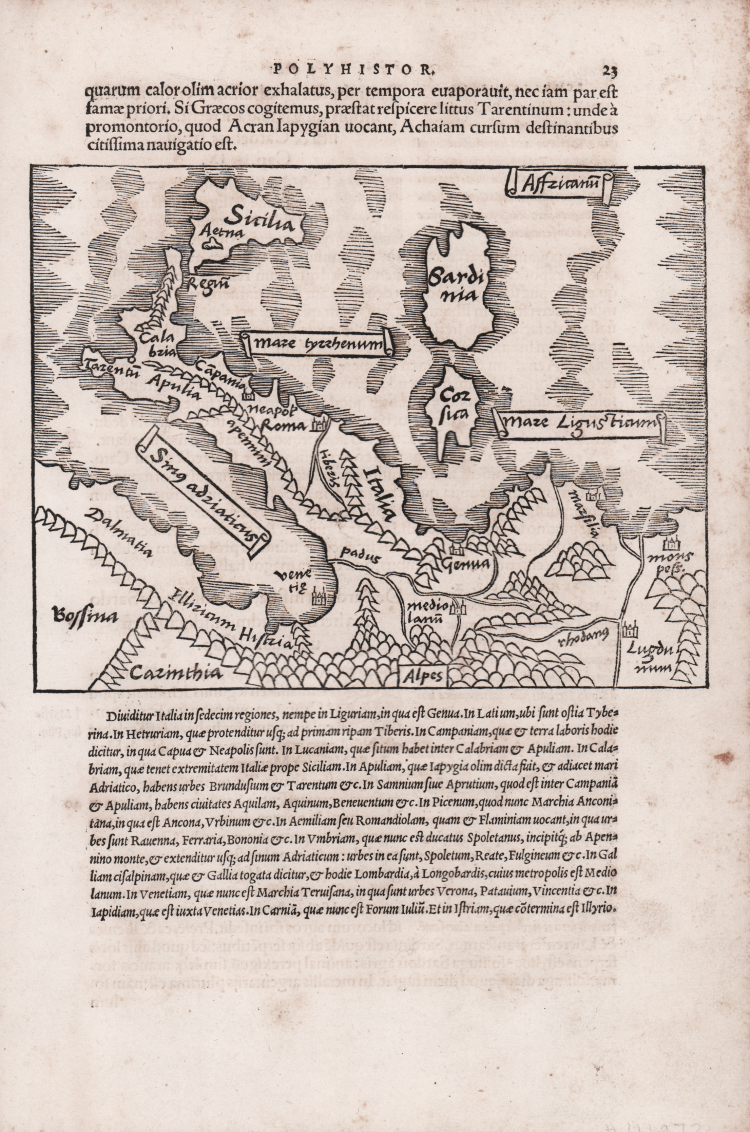



| Reference: | s21275 |
| Author | Sebastian Münster |
| Year: | 1538 |
| Zone: | Italy |
| Printed: | Basle |
| Measures: | 160 x 130 mm |


| Reference: | s21275 |
| Author | Sebastian Münster |
| Year: | 1538 |
| Zone: | Italy |
| Printed: | Basle |
| Measures: | 160 x 130 mm |
Map of Italy taken from Polyhistor Rerum Toto Urbe Memorabilum by Caius Iulius Solinus Polyhistor, printed in Basile by Henri Petri inl 1538.
Solinus's Polyhistor is a collection of geographical accounts edited by Sebastian Münster. This work is renowned for its inclusion of a printed map bearing the earliest representation of the northwest coast of America as "Terra incognita" in the upper right-hand corner of the folding map of "Asia Major," the first complete map of Asia. This same map also shows one of the earliest depictions of a strait between Asia and America, nearly 200 years before Vitus Bering famously voyaged to this part of the world. At the time of publication, scholars and voyagers were still debating the plausibility of a land mass connection between the Asian and American continents. The Polyhistor also includes a second, detailed folding map of the Greek Isles and parts of modern day Turkey and Eastern Europe. Solinus was a legendary Roman geographer, grammarian and anthologist. His Polyhistor incorporated much of Pliny s Natural History and included Pomponius Mela s geography. There are brief remarks on a number of historical, social, religious and natural history questions. The Polyhistor was first issued in the middle of the third century. Münster, the editor of the 1538 and 1543 editions of the Polyhistor, is quite a significant figure in the history of sixteenth-century cartography.
The work has been illustrated with 18 maps, ascribed to Muenster, who wrote the text of the book.
Woodcut, Latin text on verso, excellent condition.
|
R. Borri "L'Italia nelle antiche carte…" (2011), scheda 27
|
Sebastian Münster (1488 - 1552)
|
Sebastian Münster was a German cartographer, cosmographer, and Hebrew scholar whose Cosmographia (1544; "Cosmography") was the earliest German description of the world and a major work - after the Nuremberg Chronicle of 1493 - in the revival of geography in the 16th-century Europe. Altogether, about 40 editions of the Cosmographia appeared during 1544-1628. Although other cosmographies predate Münster's, he is given first place in historical discussions of this sort of publication, and was a major influence on his subject for over 200 years.
In nearly all works by Münster, his Cosmographia is given pride of place. Despite this, we still lack a detailed survey of its contents from edition to edition, along the years from 1544 to 1628, and an account of its influence on a wide range of scientific disciplines. Münster obtained the material for his book in three ways. He used all available literary sources. He tried to obtain original manuscript material for description of the countryside and of villages and towns. Finally, he obtained further material on his travels (primarily in south-west Germany, Switzerland, and Alsace). The Cosmographia contained not only the latest maps and views of many well-known cities, but included an encyclopaedic amount of details about the known - and unknown - world and undoubtedly must have been one of the most widely read books of its time.
Aside from the well-known maps and views present in the Cosmographia, the text is thickly sprinkled with vigorous woodcuts: portraits of kings and princes, costumes and occupations, habits and customs, flora and fauna, monsters and horrors. The 1614 and 1628 editions of Cosmographia are divided into nine books. Nearly all the sections, especially those dealing with history, were enlarged. Descriptions were extended, additional places included, errors rectified.
|
|
R. Borri "L'Italia nelle antiche carte…" (2011), scheda 27
|
Sebastian Münster (1488 - 1552)
|
Sebastian Münster was a German cartographer, cosmographer, and Hebrew scholar whose Cosmographia (1544; "Cosmography") was the earliest German description of the world and a major work - after the Nuremberg Chronicle of 1493 - in the revival of geography in the 16th-century Europe. Altogether, about 40 editions of the Cosmographia appeared during 1544-1628. Although other cosmographies predate Münster's, he is given first place in historical discussions of this sort of publication, and was a major influence on his subject for over 200 years.
In nearly all works by Münster, his Cosmographia is given pride of place. Despite this, we still lack a detailed survey of its contents from edition to edition, along the years from 1544 to 1628, and an account of its influence on a wide range of scientific disciplines. Münster obtained the material for his book in three ways. He used all available literary sources. He tried to obtain original manuscript material for description of the countryside and of villages and towns. Finally, he obtained further material on his travels (primarily in south-west Germany, Switzerland, and Alsace). The Cosmographia contained not only the latest maps and views of many well-known cities, but included an encyclopaedic amount of details about the known - and unknown - world and undoubtedly must have been one of the most widely read books of its time.
Aside from the well-known maps and views present in the Cosmographia, the text is thickly sprinkled with vigorous woodcuts: portraits of kings and princes, costumes and occupations, habits and customs, flora and fauna, monsters and horrors. The 1614 and 1628 editions of Cosmographia are divided into nine books. Nearly all the sections, especially those dealing with history, were enlarged. Descriptions were extended, additional places included, errors rectified.
|